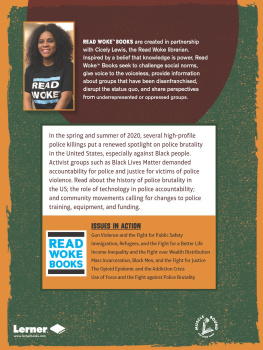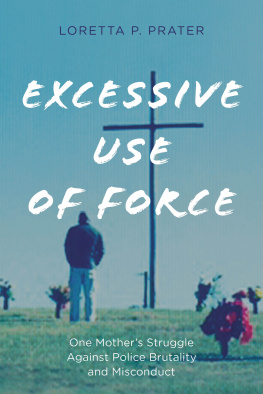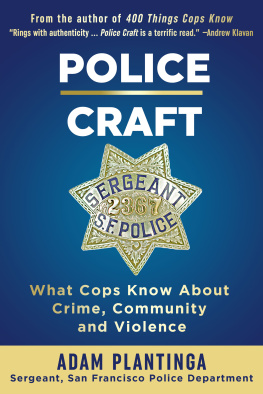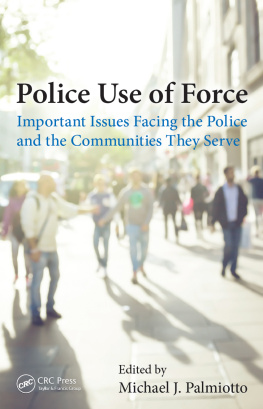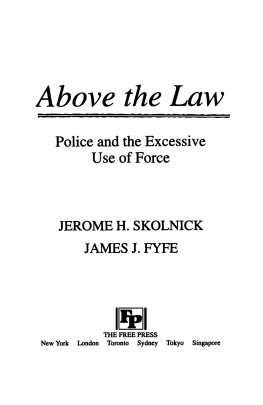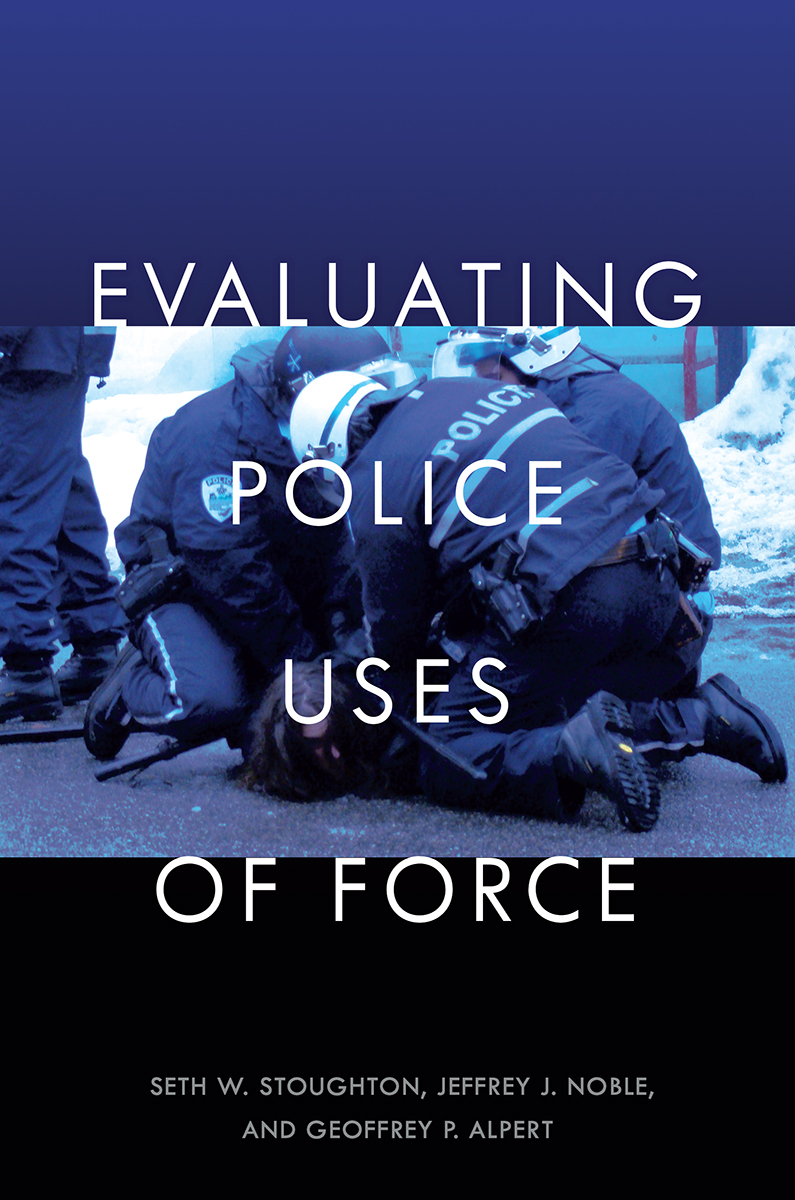
Evaluating Police Uses of Force
Evaluating Police Uses of Force
Seth W. Stoughton, Jeffrey J. Noble, andGeoffrey P. Alpert

NEW YORK UNIVERSITY PRESS
New York
NEW YORK UNIVERSITY PRESS
New York
www.nyupress.org
2020 by New York University
All rights reserved
References to Internet websites (URLs) were accurate at the time of writing. Neither the author nor New York University Press is responsible for URLs that may have expired or changed since the manuscript was prepared.
Library of Congress Cataloging-in-Publication Data
Names: Stoughton, Seth W., author. | Noble, Jeffrey J., author. | Alpert, Geoffrey P., author.
Title: Evaluating police uses of force / Seth W. Stoughton, Jeffrey J. Noble, Geoffrey P. Alpert.
Description: New York : New York University Press, 2020. | Includes bibliographical references and index. | Summary: Evaluating Police Uses of Force is an exploration of how police violence is regulatedProvided by publisher.
Identifiers: LCCN 2019030941 | ISBN 9781479814657 (cloth) | ISBN 9781479833542 (paperback) | ISBN 9781479830480 (ebook) | ISBN 9781479803798 (ebook)
Subjects: LCSH: Police brutalityUnited States. | Police misconductLaw and legislationUnited States. | Police patrolUnited States.
Classification: LCC KF5399 .S76 2020 | DDC 344.7305/232dc23
LC record available at https://lccn.loc.gov/2019030941
New York University Press books are printed on acid-free paper, and their binding materials are chosen for strength and durability. We strive to use environmentally responsible suppliers and materials to the greatest extent possible in publishing our books.
Manufactured in the United States of America
10 9 8 7 6 5 4 3 2 1
Also available as an ebook
To my wife, Alisa, for her constant love and support. To my children, Aidan and Lorelei, for inspiring me to be better than I am. And to my parents, John and Ava, for teaching me to care passionately, to question intensely, to explore fearlessly, and to read well.
I miss you, Dad.
Seth Stoughton
To my daughters, Elizabeth and Patricia. Both of you are beautiful, loving, and brilliant. I will forever be in awe of you, and I love you both deeply.
Jeff Noble
To my children, Angie, Amanda, Ryan, and Cory, and brother Spencer who have all challenged and tested me. To Peter Martin, Ian Stewart, Damien Hayden, and Bob Gee from the Queensland Police Service, and to Mark Hiron from New South Wales, who have all been mentors and friends. To Paul Mazerolle, who gave me the opportunity to conduct research in Australia. I would be remiss if I didnt thank Jeff Rojek, Scott Wolfe, Kyle McLean, Justin Nix, Louise Porter, and Justin Ready for being such great work partners.
Geoff Alpert
Contents
Figure 1.1. Simplified Spectrum of Reasonableness
Figure 1.2. Analytical Spectrum of Reasonableness
Figure 2.1. Lethal Police Shootings per 100,000 People (20152018)
Table 3.1. Administrative Regulatory Considerations
Figure 3.1. Conceptual Force Matrix
Figure 3.2. Early Los Angeles Police Department Force Continuum
Figure 3.3. Federal Law Enforcement Training Center (FLETC) Use-of-Force Model
Figure 3.4. (Former) Florida Force Matrix
Figure 3.5. Protective Safety Systems Transactional Use-of-Force Paradigm
Figure 3.6. Queensland Police Service, Situational Use-of-Force Model (2016)
Figure 3.7. Royal Canadian Mounted Police Incident Management Intervention Model
Arif Alikhan
With controversial police shootings capturing the attention of the nation, it has never been more important to understand when and how a police officer may use force. As a senior police executive, however, I experienced firsthand the difficulty of explaining the law and different policies regarding when an officer may use physical force against a suspect.
There are 18,000 different police agencies in the United States, each following different administrative policies, operating within different judicial districts, and serving different communities with varying expectations. This has resulted in a patchwork of legal interpretations, policies, and community standards that often conflict and can cause significant confusion among police professionals and the public.
Law enforcement experts Seth Stoughton, Geoffrey Alpert, and Jeff Noble provide a comprehensive explanation of the many factors that surround a police officers decision to use physical force and provide useful guidance on how to navigate the complexities of the law and policy in police uses of force. In these pages, they use their diverse experiences as leading police researchers, accomplished authors, and former police officers to simplify the complex concepts into understandable and useful explanations of when and how an officer may use force to apprehend a suspect, to defend themselves, or to defend others.
I have had many spirited debates with these learned gentlemen and greatly value their important insights about the gaps and contradictions in the law. Unlike most books on uses of force, they go beyond the typical constitutional analysis and discuss the impact of dozens of state laws and thousands of administrative policies that influence the subject. Most importantly, they address how community expectations often differ, and even conflict, with what the law allows and policies define as permissible.
Arif Alikhan is a Senior Fellow at the University of Chicago Crime Lab and the former Director of Constitutional Policing and Policy at the Los Angeles Police Department (LAPD). He previously served as the Deputy Executive Director for Homeland Security, Law Enforcement, and Fire/EMS at Los Angeles World Airports, as a Distinguished Professor of Homeland Security and Counterterrorism at the National Defense University, as the Assistant Secretary for Policy Development at the Department of Homeland Security during the Obama administration, as a senior advisor to Attorneys General John Ashcroft and Alberto Gonzalez, and as an Assistant United States Attorney. The opinions expressed above are his personal opinions and do not necessarily reflect the opinions of the University of Chicago and its affiliates.
Deciding whether to use physical force is among the most serious and consequential decisions a police officer can make. The decisions are often made during intense and uncertain circumstances. They are also captured on video for the world to see and pass judgment on, often with little or no understanding of the law governing these interactions or the policies that guide officers decisions. This important book, long overdue, will help police executives, legal professionals, researchers, and the public understand, assess, and have the ability to explain when and how a police officer may use force to protect the communities they serve.
What does a police officer in the United States look like? There is no way for us to foresee, as we write this months or years before you read it, the details of the officer youre imagining right now. They may be tall or short, male or female, white or black, uniformed or in plainclothes; there are an infinite number of variations. Yet we can confidently predict that the officer youre picturing is armed. At a minimum, they have a handgun, but they may be wearing a duty belt or tactical vest outfitted with pepper spray, a baton, or a TASER; they may be carrying a shotgun, a rifle, or a transparent shield and a riot baton. You may even have pictured an officer using force, mentally replaying one of the many videos of police shootings or other uses of force that have been prominently featured in the news.
Next page

